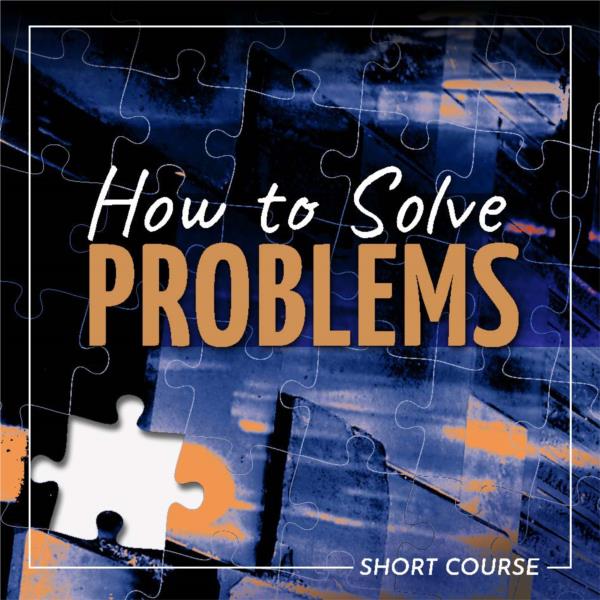Home > Short Courses
How to Solve Problems- Short Course
Sneak Peek
This course is designed to broaden and deepen your capacity to solve problems, in a work situation through to your personal and social life. Everyone has problems they need to solve. That’s life. This course is particularly useful as professional development for managers, supervisors, investors and business owners who often need to apply problem solving in their daily work. Problems can also arise in other situations too; from dealing with conflict in a social situation, to financial problems at a personal level.
There are many techniques and tools that are used to solve problems. This course teaches you some of the more important and useful ways of approaching and working through problems, and in doing so boosts your problem solving capacity and confidence.
What's inside the 'How to Solve Problems?' Course?
LESSON 1 WHAT IS PROBLEM SOLVING?
- Introduction
- Consider Timing and Resources
- Why are Problem Solving Skills Important?
- Problem Solving Skills at Work, In Education and Elsewhere
- Problem Solving Skills
- Problems or Opportunities?
- Other Problem-Solving Methods
- Programmed or Non-programmed Decisions
- Creative Problem Solving (CPS)
- Finding Solutions – the Seven Step Plan
- Problem Solving and Employability
- The Art of Delegation
- Lesson 1 additional reading
- Review what you have been learning
LESSON 2 DEFINING THE PROBLEM
- What Do We Want to Accomplish?
- Problems or Opportunities
- Aim: Describe how to define problems.
- Are We Defining the Right Problem?
- Root Cause Analysis
- Data Collection – having suitable information for problem solving
- Discovering the Causes of a Problem
- Lesson 2 additional reading
- Review what you have been learning
LESSON 3 CLARIFYING THE PROBLEM
- Aim: Describe how to clarify problems.
- Clarifying The Problem
- Developing a clear problem statement
- Lesson 3 additional reading
- Review what you have been learning
LESSON 4 RESOURCES AND TIME TO SOLVE THE PROBLEM
- What Are Resources?
- Aim: Explain the resources and time involved in solving problems.
- Rationality
- Bounded Rationality
- Time
- Prioritising Problems – not being able to solve everything
- Lesson 4 additional reading
- Review what you have been learning
LESSON 5 INFORMATION, RELEVANT FACTS, BIAS AND PREJUDICE IN PROBLEM SOLVING
- Aim: Describe factors that can affect problem solving, such as information, factors, bias, and prejudice. 39
- Where Can Information Be Located?
- Risk
- The Impact of Bias in Problem Solving
- Imagine this situation.
- Lesson 5 additional reading
- Review what you have been learning
LESSON 6 ETHICS AND PRIORITIES
- Foundational Principles
- Aim: Apply ethical considerations to problem solving.
- Ethical Factors
- Analyse The End Result
- Analyse The Actions
- Decide
- Applying Ethics to Problem Solving
- Case Study
- Lesson 6 additional reading
- Review what you have been learning
LESSON 7 IDENTIFYING BEST SOLUTIONS AND PUTTING THEM INTO PRACTICE
- Aim: Describe how to identify the best solutions and put them into practice
- Deciding On the Best Solution
- Factors Affecting What Is the Best Solution
- The Action Plan
- Creating an Effective Action Plan
- Don’t Reinvent the Past – Become Educated for the Future
- Lesson 7 additional reading
- The Dangers of Sticking to the Obvious or Reinventing the Past
- Learn to think and problem solve: Rote learning can be problematic
- Recognise Neurodiversity
- Up to Date
- Niche and Widespread Requirements
- Lifelong Learning
- How to solve problems faster
- Review what you have been learning
LESSON 8 EVALUATING YOUR SOLUTION
- How Will the Solution Be Evaluated?
- Aim: Explain how to evaluate problem solving solutions
- Time Frames
- Staff or Responsible Person
- In Conclusion
- Review what you have been learning
- Final Assessment
Write a Review
Please ensure you are logged in to write a review.
How to Solve Problems- Short Course

£100.00
In stock